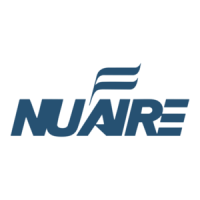6
15. 02. 22. Document Number 672040
Nuaire | Western Industrial Estate | Caerphilly | CF83 1NA | nuaire.co.uk
BPS H-CO
Installation Manual
1.27 Typical Basic Commissioning
•Set the analogue variables “Extract Fan Min Speed”, “Supply Fan
Min Speed”, “Extract Fan Max Speed” and “Supply Fan Max Speed”
during commissioning.
•If flow measurements are required enable the unit using the
“Enable” MSV and boost the unit using the “Fan Boost” MSV.
1.28 Typical Basic Operation
•Enable the unit using the MSV “Enable” object. The fan runs at min
speed.
•Increase the fan speeds using the AV “Fan Speed Demand” 0-100%
(0% = Min Commissioned Speed, 100%= Max Commissioned
Speed).
•Adjust setpoint using the AV “Software Setpoint”.
1.29 Writing Directly To Outputs
•It is not recommended to write directly to outputs since the
internal logic of the control will be bypassed and some features
will not function. The unit may also start without an enable signal.
•However, if this is required for test purposes (or otherwise),
priority level 8 must be used.
•The internal control logic writes at priority level 16 so any data
written to the outputs at this level is at risk of being overwritten.
•These values must be relinquished or nulled once used, otherwise
the outputs will be locked at that value, even if the value is “0”.
1.30 Priority Array Storage
•Priority levels 8 & 16 are stored in the controller following a power
cycle. All other levels are reset to null.
•Level 16 is not to be used for controller outputs since it will be
overridden by the internal logic during operation.
1.31 Devices
A BACnet network can consist of several "device objects". Each device
is given a unique "Device Instance Number". A typical example of a
device is a controller or BACnet compatible LCD. EcoSmart Connect
controllers are assigned a random device instance number at the
factory and do not need to be changed. The instance number range is
1 - 4,194,303 (2
22
). EcoSmart Connect controllers use a MSTP network
for communication and are assigned a default MSTP address of 4.
The MSTP address must not be confused with the Device Instance
Number. Most network browsers can identify a device by the Device
Instance Number or the MSTP address.
1.32 Objects
In BACnet, information is stored within devices as several ‘virtual’
objects. Some examples of these are Fresh Air Temperature, Extract Fan
Speed, CO2 Target, etc. Each object has several properties but the most
important are shown in the table below. The maximum number of
objects in a device is 4,194,303 (2
22
) of each type.
Object Name The name of the object. E.g. Setpoint
Object Instance
Number
A unique number which represents the object within
the device. E.g. 12544
Object Type The type of object. E.g. Analogue Variable (AV)
Description A short description of the object. E.g. The room
setpoint
Present Value The current value of the object. E.g. 20
Units The units of the present value. E.g. °C
1.33 Object Types
A list of some typical object types is shown below.
AI Analogue
Input
An analogue object which is a physical input to a device.
AO Analogue
Output
An analogue object which is a physical output from a
device.
AV Analogue
Variable
An analogue object which exists within a device.
BI Binary
Input
A true/false object which is a physical input to a device.
BO Binary
Ouput
A true/false object which is a physical output from a
device.
BV Binary
Variable
A true/false object which exists within a device.
MSV Multi-
State
Variable
This is an enumerated object which can have a number
of states, each represented by a number. This is similar
to a dropdown menu in windows forms. The State_Text
property is an array containing the text for each value.
Some browsers may not be able to read the text values
so both are provided in this manual. E.g. 1=Off, 2=Low,
3=High, 4=Auto
SCH Schedule
Object
This is a special object with the ability to have a
changing value depending on the time of date or day of
the week.

